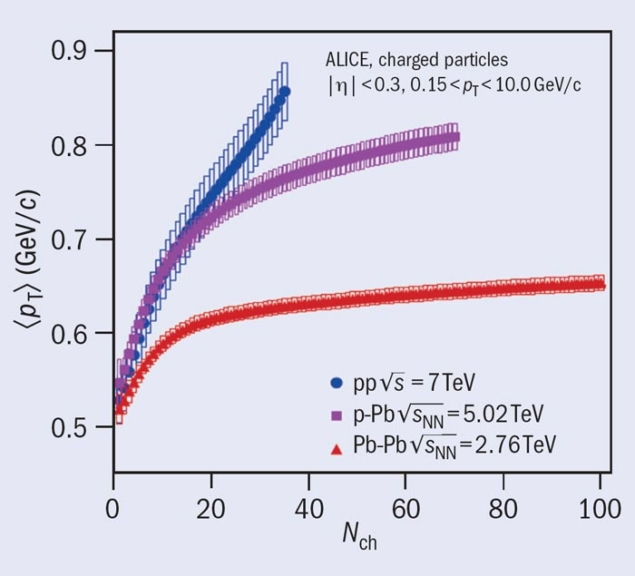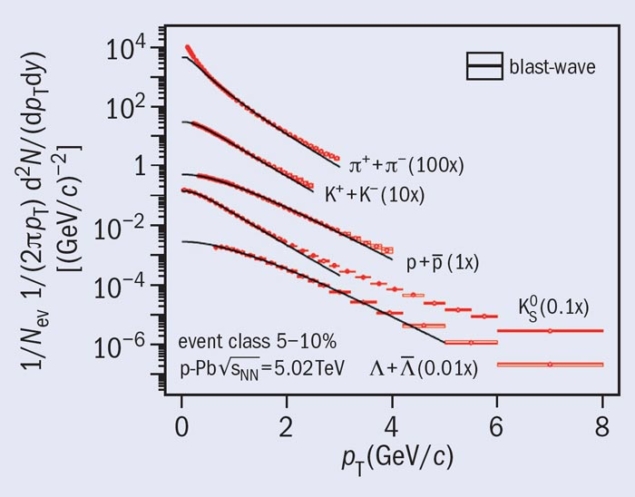One of the key ways of looking into what happens when high-energy hadrons collide is to measure the relationship between the number, or multiplicity, of particles produced and their momentum transverse to the direction of the colliding beams. The results cast light on processes ranging from the interactions of individual partons (quarks and gluons) to the collective motion of hot, dense matter containing hundreds of partons. The ALICE experiment is investigating effects across the range of possibilities, using data collected with proton–proton (pp), proton–lead (pPb) and lead–lead collisions (PbPb) in the LHC – and the results are showing some surprises.
A correlation between the average transverse momentum 〈pT〉 and the charged particle multiplicity Nch was first observed at CERN’s SppS collider and has since been measured in pp(p) collisions over a range of centre-of-mass energies, culminating recently at the LHC. The strong correlation observed led to a change in paradigm in the modelling of such collisions, with the proposal of mechanisms that go beyond independent parton–parton collisions.
In pp collisions, one way to understand the production of high multiplicities is through multiple parton interactions, but the incoherent superposition of such interactions would lead to the same 〈pT〉 for different values of multiplicity. The observation of a strong correlation thus led to the introduction, within the models of the PYTHIA event simulator, of colour reconnections between hadronizing strings. In this mechanism, which can be interpreted as a collective final-state effect, strings from independent parton interactions do not independently produce hadrons, but fuse before hadronization. This leads to fewer, but more energetic, hadrons. Other models that employ similar mechanisms of collective behaviour also describe the data.

In PbPb collisions, high-multiplicity events are the result of a superposition of (single) parton interactions taking place in a large number of nucleon–nucleon collisions. In this case, substantial rescattering of constituents is thought to lead to a redistribution of the particle spectrum, with most particles being part of a locally thermalized medium that exhibits collective, hydrodynamic-type, behaviour. The moderate increase of 〈pT〉 seen in PbPb collisions (shown in figure 1 for Nch around 10 or larger) is thus usually attributed to collective flow.
Now, the first measurements by ALICE of two-particle correlations in the intermediary system of pPb collisions have sparked an intense debate about the role of initial- and final-state effects. The pPb data on 〈pT〉 indeed exhibit features of both pp and PbPb collisions, at low and high multiplicities, respectively. However, the saturation trend of 〈pT〉 versus Nch is less pronounced in pPb collisions than in PbPb and at high multiplicities leads to a much higher value of 〈pT〉 than in PbPb. Is this nevertheless a fingerprint of collective effects in pPb collisions? Predictions that incorporate collective effects within the hadron interaction model EPOS describe the data well, but alternative explanations, based on initial-state effects (gluon saturation), have also been put forward and are being tested by these data (ALICE collaboration 2013 a).
Other recent measurements of particle production in proton–nucleus collisions have shown unexpected behaviour that is reminiscent of quark–gluon plasma (QGP) signatures. But what could cause such behaviour and is a QGP the only possible explanation? To answer this in more detail, it is important to separate particle species, as collective phenomena should follow an ordering in mass. To this end, ALICE has measured the transverse-momentum spectra of identified particles in pPb collisions at √sNN = 5.02 TeV and their dependence on multiplicity (ALICE collaboration 2013b).
The measurements show that the identified particle spectra become progressively harder with multiplicity, just as in PbPb collisions, where the hardening is more pronounced for particles of higher mass. In heavy-ion collisions, this mass ordering is interpreted as a sign of a collective radial expansion of the system. To check if such an idea describes the observations, a blast-wave parameteriz ation can be used. This assumes a locally thermalized medium that undergoes a collective expansion in a common velocity field, followed by an instantaneous common freeze-out.

As figure 2 shows, the blast-wave fit describes the spectra well at low pT, where hydrodynamics-like behaviour should dominate. The description fails at higher momenta, however, where the non-thermal components should contribute significantly. But are QGP-like interpretations such as this one unique in describing these measurements? The colour-recombination mechanism present in PYTHIA, discussed above, leads qualitatively to similar features to those observed in the data.
The presence of flow and of a QGP in high multiplicity pPb collisions is thus not ruled out, but since other non-QGP effects could mimic collective phenomena, further investigation is needed. Nevertheless, these results are certainly a crucial step towards a better comprehension not only of pPb collisions but also of high-energy collisions involving nuclei in general.
Further reading
ALICE collaboration 2013a arXiv:1307.1094 [nucl-ex].
ALICE collaboration 2013b arXiv:1307.6796 [nucl-ex].





